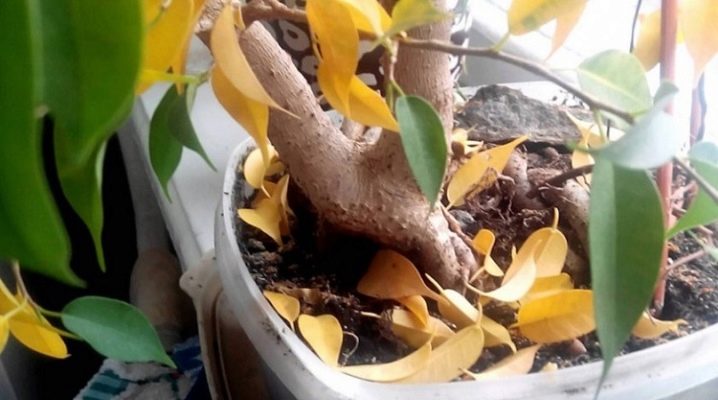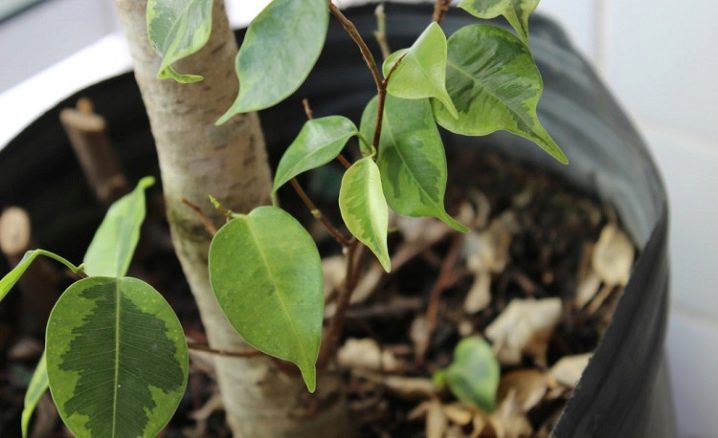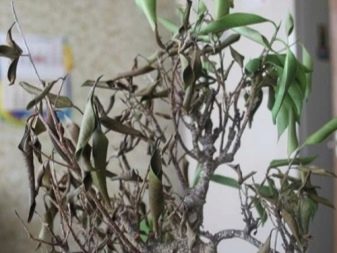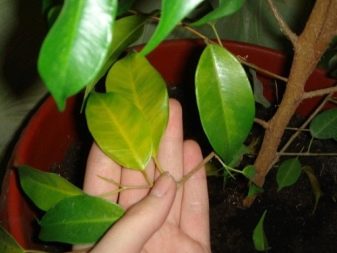What to do if the leaves of the ficus are falling?

The presence of indoor plants in the room has an extremely positive effect, but in order for green spaces to please with good growth and development, it is important to be able to properly care for them. Florists who grow ficus can face the problem of leaf fall, which is difficult to solve without special knowledge in this area. Determining the reasons, as well as the only correct decisions in each specific situation, will help the plant not only fully recover, but also grow with greater strength.

Causes
If a bought or donated ficus suddenly ceases to please the eye, leaves turn yellow and fly around on it, then you should immediately sound the alarm and find out what is the reason for such a change. There can be quite a few factors for this, so it is so important to determine exactly what happened to the ficus and help it if necessary.
Consider the main reasons why leaves of a ficus can fall off.

Natural
The plant independently sheds old foliage, which consumes too many nutrients, and after photosynthesis, practically nothing is released. Such a process is not a problem, because the bush simply rejuvenates itself, makes it possible for young foliage to appear, which will be more beneficial for the ficus and the environment.
These metamorphoses can be observed in autumn, usually towards the end of October. The duration of the change of leaf cover is from one to two months. During this period, it is worth minimizing the care of the ficus by reducing watering and fertilizing so that the old leaves fall off faster and the bush can replace the old foliage with new one.

Low temperatures
Inappropriate conditions of detention in the form of cold and humidity - in winter, more frequent discharge of sheets can be noted in those regions where the ambient temperature varies significantly from warm to cold. The threshold temperature at which foliage crumbles in ficus is +14 degrees. This is necessary for the bush in order to preserve vitality before the onset of heat.
To prevent the ficus from freezing, it does not need to be left for the winter in an unheated room, and a sharp decrease in the temperature indicators of the environment should also be avoided.
In terms of moisture, low moisture levels will also help to shed foliage. With unfavorable moisture indicators, the crown turns yellow and dries if it does not receive enough moisture from their soil.
In such extreme conditions, a shortage of nutrients will begin, and the ficus will remain without leaves.

High temperatures
Hot conditions and too warm air for the plant are just as dangerous as cold ones. Leaves fall off in the summer if the temperature exceeds +26 degrees. The plant dries up quickly enough, even if it has good watering and the moisture level remains within normal limits.
A feature of the ficus is the lighting mode, it does not like direct sunlight, but at the same time it cannot exist normally without light.
Only the right place for the pot, optimal temperature and humidity, can prevent the process when the bush throws off the foliage.

Lack of nutrients
If the conditions of the plant are correct, but the green leaves begin to dry and turn yellow, then the problem is a lack of fertilizers. To save the bush and prevent foliage from falling off, you need to add more nutrients to the soil and carry out such activities regularly.
However, in this case, it is important to be careful not to overdo it with the amount of fertilizer, because an excessive portion of nutrients will lead to overgrowth of the bush, which will cause negative consequences.


Improper watering
Ficus is a difficult plant to care for due to the difficulty of watering. It is important to give it as much moisture as needed, taking into account the temperature and humidity, since a lack or excess of it will have detrimental consequences.
In moist soil, harmful microorganisms and bacteria begin to actively develop, and the process of rotting of the root system is activated. Root problems are very quickly transmitted to the entire plant, which leads to its complete defeat. If the ficus sharply dropped the leaves, the problem may be precisely in watering, so it is worth assessing the condition of the soil, whether it is too dry or, conversely, swampy.
If the problem is resolved immediately after its detection, the ficus recovery process proceeds without serious complications. However, if the moment is delayed in time, then the branches will also begin to die off, and the bush may lose its attractiveness.
Dry soil also causes problems with the greenery on the plant, since the process of oxygen starvation will be launched, from which the lower leaves, and behind them the rest, turn yellow, curl and fall off.
It is important to quickly understand any changes that occur with the ficus, so as not to lose the plant at all.

Inappropriate soil acidity
Ficus belongs to those crops that are very demanding on the acidity of the soil in which they grow. For optimal growth and development, only land with low acidity is suitable. If the acidity level is increased, then the solution to the problem will be a complete replacement of the soil.
Only after transplanting it will be possible to notice positive changes in terms of foliage growth on the bush. Fertilizers will help to cope with the low acidity level, which will saturate the soil with everything you need, and the small-leaved shrub will again begin to grow in full force.

Diseases and pests
With improper care of the plant, problems begin not only with its growth and development, but also a favorable environment is created for the development of harmful microorganisms and diseases.
The most common are:
- root rot;
- yellowing and discoloration of foliage;
- leaf spot;
- the presence of dark brown spots.


Pests are much more dangerous:
- spider mite;
- shield;
- mealybug.
Only by carefully examining the plants, you can notice changes of one kind or another on them and immediately begin to fight against them. Appropriate spraying helps with diseases, and insecticides must be used for pests.
There are a lot of reasons for the fall of ficus leaves, but only after having dealt with all in detail, you can choose the best care option, which minimizes the possibility of the appearance of most of them. Timely noticed problems will make it possible to save the bush without harming it.
Any delays can lead to large-scale fall of foliage, drying of branches, severe damage to the bush.

What to do?
Since the ficus is a rather demanding plant, any changes that are unpleasant for it in the form of a change in the place of growth, transplantation, temperature changes and care errors lead to the plant losing its foliage. In this case, it is possible to save him, the main thing is to start treatment on time and correctly determine the essence of the problem.
Seeing the first signs of negative changes, it is worth assessing the correct position of the pot and caring for the plant.

The presence of proper lighting without the presence of a bright sun, timely and moderate watering, which changes depending on the season, and the introduction of useful additives that contribute to the full development of the bush are all necessary conditions, without which the ficus will not be able to maintain its normal appearance for a long time. If any of the conditions is violated, you should fix it immediately:
- as soon as the bush has thrown off more leaves than usual, it is worth spraying the trunk and crown with Epin;
- with dry soil, it is imperative to water it, and if necessary, also feed the plant;
- if the soil is waterlogged, it is worth checking the integrity of the root system, which can gradually begin to rot, and this process cannot be allowed;
- if the bush is sick, it is important to determine exactly what exactly and spray it with the appropriate solution.
You can solve any problem if you do not delay with this and correctly determine the root cause of leaf fall, otherwise there is a risk of global problems with the ficus, up to its complete drying.


Home care
In order for the ficus to grow correctly and delight with its green leaves for many years, it is important to create optimal conditions for it.

Correct and sufficient lighting
Due to the tropical origin of the plant, the most important factor for it is the presence of a large amount of light. Since there is a certain species diversity, the conditions of their maintenance may differ slightly.
Those variants with darker foliage are able to stay longer in shading conditions; for plants with light foliage, light is the most important condition for growth.
Species with variegated leaves can even tolerate direct sunlight, while other options should be hidden in partial shade. In winter, when there is not enough daylight, it is important for the ficus to organize additional lighting. This can be done using a special lamp, which will make it possible to illuminate the bush for at least 12 hours a day.
To make the crown uniform and beautiful, it is worth turning the pot in different directions, exposing the greenery to the light source.

Suitable humidity level
High humidity is common for ficus, but its range should also be kept within certain limits. For good growth of the bush, it is worth spraying it or placing it under the shower. Those varieties that have large leaves must be wiped with a damp cloth, because dust collects on the surface of the leaf plate, which prevents the plant from functioning normally.

Optimum air temperature
Tropical conditions are the most comfortable for ficus, so keeping it in summer at a temperature of 20-25 degrees, and in winter 15-20 degrees, will be the most optimal. The minimum indicators are 10-15 degrees, at which it is worth removing the plant in a warmer room.
It is very important to protect the ficus from drafts and hypothermia of the soil, which very much affect the general condition of the plant.
It is worth choosing a well-insulated window sill, the window on which will be closed.

Watering conditions
For different seasons, the amount of moisture applied to the soil will differ. More water is needed in summer, less in winter. The next watering should be done only when the soil is dry, but not completely dry. With a cold snap, watering decreases, since waterlogging of the soil leads to root rot and the development of diseases.
Ampel varieties of ficus need more watering than ordinary ones.

Plant fertilization
It is necessary to apply fertilizers to the pot with ficus when the plant is in active growth. The most suitable time frames for this start in March and end in September. Nutrients are added every two weeks.
The correct composition should contain a large amount of nitrogen, which makes it possible to stimulate the growth of the green part of the bush.


Transfer
The growth of ficuses is quite fast, because every year they need to be transplanted, changing the soil and, if necessary, the pot, or planting the plant. The optimal month for this procedure is March. The pot should not be taken very large, as due to the large amount of soil, growth becomes slower. A drainage layer is necessarily laid out on the bottom.
Ficuses are not very susceptible to diseases, but sometimes you can see spider mites, scale insects or tips on them, for which it is appropriate to use insecticides.
If the ficus grows in one place and the conditions are completely suitable for it, it is not worth changing anything, measures should be taken only if any problems arise.

Advice
In the event of a sudden shedding of the foliage of a ficus tree, when the causes are not natural, it is necessary to check all possible options and highlight the one that is most likely to be the cause of damage to the plant.

There are some tips to help prevent foliage from shedding.
- It is worth paying attention to the soil, how much it is watered and whether it is overdried. In case of waterlogging of the soil, watering should be completely stopped for two weeks in order to completely dry the soil and roots. If this measure does not lead to the restoration of plant health, you should try to transplant it into new soil and water it a little.
- One of the reasons for the loss of the crown may be a lack of nutrients, and if so, then you just need to add a solution containing phosphorus, nitrogen, potassium. You can use organic matter in the form of chicken manure, mullein and humus, and from improvised means can help: coffee grounds, sugar, waste from fruits and vegetables, yeast, nettle infusion, ash and tea leaves. Among the most popular drugs are "Rainbow", "Agricola" and "Pocon".
- Examine the bush for pests. It is important to pay attention to the soil in which the ficus grows, to check if there are any harmful microorganisms in it, and also to examine the branches and crown. If insects are found, they must be dealt with immediately with the help of insecticides. The scabbard must be fought with soapy water, which is used to wipe all the leaves. If this does not help, you can use the drug "Actellik". It is better to cut off the affected areas that could not be saved. Spider mites can be fought by washing with plain warm water and increasing the humidity in the room. At a serious stage, Actellik will help out.
- The reason for the falling leaves may be hidden in the root system, so it must be carefully examined. The ficus is removed from the pot, all the soil is removed and the roots are carefully examined for rot. If damaged areas are found, they are removed, and the cut site is lubricated with crushed coal, followed by transplantation into a new pot.

The causes of foliage falling can be of a different nature, but their timely identification makes it possible to save the plant before any serious changes begin.
See below for more details.































The comment was sent successfully.